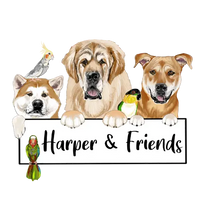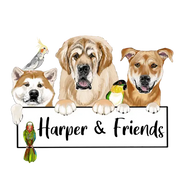Once Daily Feeding?
While these types of studies are important, it’s important not to get ahead of them and jump to conclusions. This is why we absolutely despise memes or infographics, as so much information gets lost when trying to fit all the information on a single image. It’s also important to remember that every dog is ultimately an individual and what works for one, may not work for the next.
Reasons to not switch to Once a Day.
There are multiple reasons why switching to once a day might not be the best choice for your individual dog.
- Health Conditions or Medications
If you are considering changing your dog’s feeding schedule and your dog has a health condition or is on medications, you should consult with your veterinarian first before switching.
- Large or Giant Breed/Breeds at higher risk of Bloat/GDV
Bloat is a significant health concern for many breeds.
Bloat is entirely unpredictable it can happen during or after any mealtime. While there are many theories surrounding the cause of Bloat or GDV, there are few definitive answers. One commonly agreed-on risk factor is feeding one large meal. See American College of Veterinary Surgeons, Merck Veterinary Manual, American Kennel Club Canine Health Foundation
Feeding any large or giant breed their daily calories in one sitting is not necessarily possible or recommended. This same general logic would also apply to other sized dogs as well, as the amount is relative to the dog’s size, and forcing them to eat their food in one meal may cause them to vomit.
This is especially true for Great Danes (higher risk of Bloat), who often have higher resting energy requirements than other large and giant breeds.
If you are considering switching you should have a conversation with your veterinarian or if applicable your breeder or even someone at the national or local breed club.
- Hunger Pukes
Some dogs won’t do well on once a day feeding. While some dogs may have hunger pukes and eventually adapt, many won’t, which ultimately means it isn’t an option for those dogs.
Reasons to Not Switch to Free Feeding
- Multiple Dogs
Multiple Dogs make free-feeding more difficult to measure each individual dog’s consumption. It might also result in fights between the dogs over food.
- Bloat
If your dog is a breed at higher risk of Bloat, you likely want to be present when they are eating.
- Some dogs will eat even when they are full
Overeating is a significant risk. This can be mitigated by only putting out enough food for the day, though. This still represents a challenge as some dogs will continue to eat till they vomit.
- You can only feed certain food types.
- If you are constantly adding more food, when it gets low, the fat can become rancid.
The Study
As for the study itself, it is far from conclusive evidence that once a day is better than other feeding schedules. There are multiple confounding variables that the study doesn’t take into account.
What the study did find was that the odds were lower and, more importantly, statistically significant for multiple health conditions. Notably, Gastrointestinal, Dental, Orthopedic, Kidney/Urinary, and liver/ pancreas. Other health conditions were lower such as Cardiac, Skin, Neurological, and Cancer; however, these were not statistically significant.
The Once-daily dogs did score better on the Canine Cognitive Dysfunction Rating Scale which they renamed the Canine Social and Learned Behavior Survey(CSLB). This was done to avoid skewing the results due to the negative connotation.
Important Note about free feeding.
One fascinating result was that free-fed dogs had lower odds than the once daily for Cancer, Kidney/Urinary, and Dental conditions. While the other health conditions measured were either slightly better or worse than the twice-daily. The results, however, were not statically significant. Furthermore, the free-fed dogs did perform slightly better on the CSLB survey
When discussing free feeding, there are likely many differences in the dog’s eating behavior. Making it almost impossible to elucidate a pattern among the dogs. I.e. some dogs graze throughout the day, while others eat all or the majority of their daily food intake at once, while others might eat two equally balanced portions, or the dog’s feeding behavior could change daily.
Confounding Variables
Medication and Health Conditions
Some medications need to be taken or are recommended to be taken with food.
Some health conditions are better managed with multiple small meals.
The study only looked at current feeding, not past feeding method, so it’s impossible to know how many once-a-day feeders switched to twice daily due to a medical condition or medication. This would reduce the number of health conditions in the once-daily group and increase the number in the twice or multiple groups.
Body Condition Score
One of the biggest issues is Body Condition Score as obesity is a major contributing factor to a number of health conditions.
There is evidence that plausibly suggests that dogs eating multiple times could be overfed compared to those being fed once a day.
Accurate Measurement of Food
Research shows that many of us are inaccurate at measuring food. This is possibly a significant factor that could explain a difference in BCS’s when the researchers do investigate the difference in BCS between the groups.
When only measuring food out once, there is a greater likelihood of getting a more accurate measurement of the food than those measuring out food multiple times. This is especially true when measuring amounts less than 1 cup.
Caloric Restriction
Research in laboratory Labrador Retrievers suggests that calorie restriction is beneficial for a dog’s health and longevity. This is a complicating factor for once a day as it may end up also being a form of calorie restriction.
You can evaluate this for yourself to see how accurate you are at measuring and if you might be overfeeding your dogs’ food.
Test your Measuring Accuracy
If, for example, you feed 1 cup per day with ½ cup each meal. Measure it out as you usually would with whatever tool you use to measure your dog’s food. Place it in a bowl on a food scale and measure the grams.
Next, measure out the full amount; in the above example, you would measure out 1 cup. Place it in the bowl on the food scale and measure in grams.
It is important to measure as you normally would instead of being more careful. If you are like most people, the first is likely more food than the second. You can even go a step further and look at the calories per cup, which should also include how many grams each cup should be. This can be especially important information when switching foods.
Not Open Access
This study was not published as Open Access, but here is a link to the article’s preprint. The preprint has been shared by many however there are notable differences between the preprint and the peer-reviewed published version.
I have only read the published study in full. I did, however, compare the discussion sections between the preprint and the published study, and there are some notable differences between the two.
Published:
The Analysis implicitly assumes that each dog’s feeding frequency has been the same over some meaningful period of the dog’s life. Importantly we cannot rule out the possibility that the dog owners shifted to more frequent feeding in response to health conditions, and observed associations are due in whole or part to reverse causality. This is a particular concern for gastrointestinal conditions and liver conditions, which are the two categories of health conditions with the strongest observed associations.
Preprint:
Thus, we cannot rule out the possibility that dog owners shifted to more frequent feeding in response to health conditions, and observed associations are due in whole or part to reverse causality. This is a particular concern for gastrointestinal conditions and liver conditions, which are the two health conditions with the strongest observed associations
Published:
“We view once-daily feeding to be a model of time-restricted feeding and did not expect to see associations between health and feeding frequency among dogs fed more frequently. However, our secondary analysis revealed an intriguing trend for all nine categories of health conditions, not including CSLB. Specifically, we observe higher odds of a health conditions from once daily to twice daily to three or more times daily feeding. On the other hand, free-fed dogs often did not follow this trend, we speculate that free-fed dogs represent a heterogeneous group that includes dogs with high caloric intake as well as dogs whose owners provide constant access to food because the dogs eat very little. We also recognize that free-fed dogs may naturally restrict their period of food consumption each day. While these results are intriguing, we see these analyses as exploratory and hypothesis-generating.”
Pre Print-
Not Included in Preprint
Conclusion
Ultimately it is too early to tell if different feeding schedules ie time-restricted, intermittent fasting etc., are beneficial. While there is some positive research in mice, the research on humans and this survey of dog owners is far less conclusive. The authors even admit as much.
This study is best viewed as a pilot study despite the number of survey responses. The study has some severe limitations, I’m sure if they could go back in time and add the questions they would, but they have demonstrated that it is something worthy of further investigation.
Hopefully, the attention the study has generated within the dog community will allow them to raise more money to conduct further research. Large studies such as this one (Dog Aging Project), the Golden Retriever Lifetime Study, and Darwins Ark need significant amounts of funding.
At the end of the day though every dog is an individual; what works best for one dog or even most dogs may not be the best option for your specific dog, and that is the most important thing to remember.
One of the best things you can do for your dog from a health and longevity perspective, However, is to keep them at a healthy weight.
One of the most important things to stress is measuring your dog’s food on a scale to keep a better track of the calories you are feeding. This is especially important when it comes to switching foods, as they all have different caloric densities. Some foods are as low as the mid-two hundreds per cup, while others are well in excess of six hundred. The industry is also not consistent with the recommended feeding amounts for various weights. So knowing the actual calories is important.
References
Bray, E.E., Zheng, Z., Tolbert, M.K. et al. Once-daily feeding is associated with better health in companion dogs: results from the Dog Aging Project. GeroScience (2022). https://doi.org/10.1007/s11357-022-00575-7
Coe, J. B., Rankovic, A., Edwards, T. R., & Parr, J. M. (2019). Dog owner’s accuracy measuring different volumes of dry dog food using three different measuring devices. The Veterinary record, 185(19), 599. https://doi.org/10.1136/vr.105319
German, A. J., Holden, S. L., Mason, S. L., Bryner, C., Bouldoires, C., Morris, P. J., Deboise, M., & Biourge, V. (2011). Imprecision when using measuring cups to weigh out extruded dry kibbled food. Journal of animal physiology and animal nutrition, 95(3), 368–373. https://doi.org/10.1111/j.1439-0396.2010.01063.x


